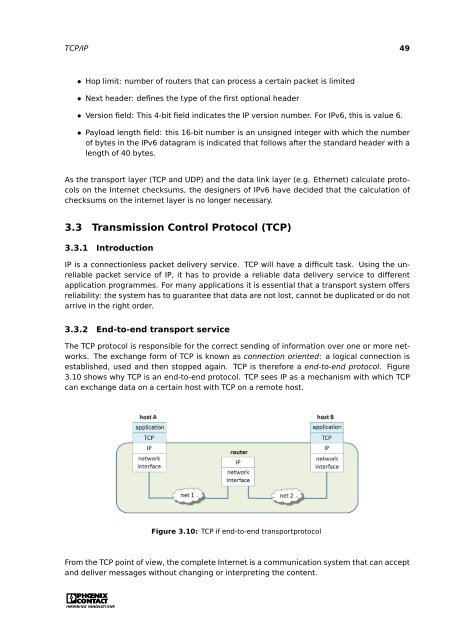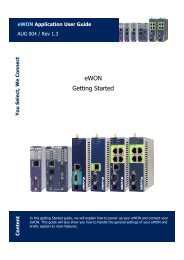Click to download Ethernet Basics manual - Grant Industrial Controls
Click to download Ethernet Basics manual - Grant Industrial Controls
Click to download Ethernet Basics manual - Grant Industrial Controls
Create successful ePaper yourself
Turn your PDF publications into a flip-book with our unique Google optimized e-Paper software.
TCP/IP 49<br />
• Hop limit: number of routers that can process a certain packet is limited<br />
• Next header: defines the type of the first optional header<br />
• Version field: This 4-bit field indicates the IP version number. For IPv6, this is value 6.<br />
• Payload length field: this 16-bit number is an unsigned integer with which the number<br />
of bytes in the IPv6 datagram is indicated that follows after the standard header with a<br />
length of 40 bytes.<br />
As the transport layer (TCP and UDP) and the data link layer (e.g. <strong>Ethernet</strong>) calculate pro<strong>to</strong>cols<br />
on the Internet checksums, the designers of IPv6 have decided that the calculation of<br />
checksums on the internet layer is no longer necessary.<br />
3.3 Transmission Control Pro<strong>to</strong>col (TCP)<br />
3.3.1 Introduction<br />
IP is a connectionless packet delivery service. TCP will have a difficult task. Using the unreliable<br />
packet service of IP, it has <strong>to</strong> provide a reliable data delivery service <strong>to</strong> different<br />
application programmes. For many applications it is essential that a transport system offers<br />
reliability: the system has <strong>to</strong> guarantee that data are not lost, cannot be duplicated or do not<br />
arrive in the right order.<br />
3.3.2 End-<strong>to</strong>-end transport service<br />
The TCP pro<strong>to</strong>col is responsible for the correct sending of information over one or more networks.<br />
The exchange form of TCP is known as connection oriented: a logical connection is<br />
established, used and then s<strong>to</strong>pped again. TCP is therefore a end-<strong>to</strong>-end pro<strong>to</strong>col. Figure<br />
3.10 shows why TCP is an end-<strong>to</strong>-end pro<strong>to</strong>col. TCP sees IP as a mechanism with which TCP<br />
can exchange data on a certain host with TCP on a remote host.<br />
Figure 3.10: TCP if end-<strong>to</strong>-end transportpro<strong>to</strong>col<br />
From the TCP point of view, the complete Internet is a communication system that can accept<br />
and deliver messages without changing or interpreting the content.




